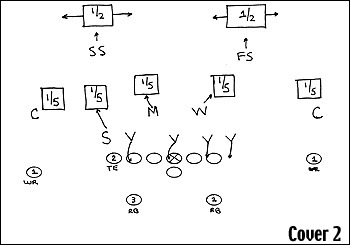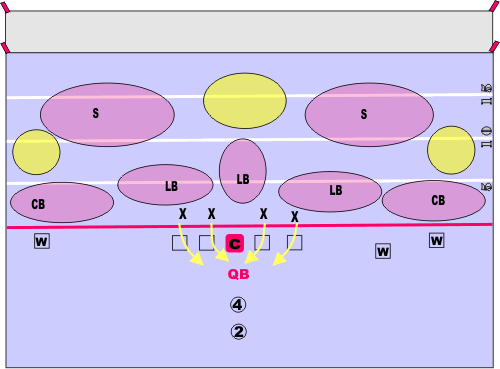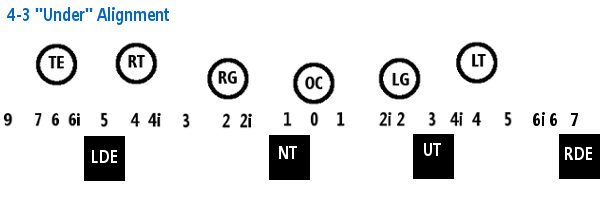Guide to NFL Defensive Schemes
Even having the slightest amount of knowledge in NFL defensive schemes can give you a huge advantage in rising the ranks, and beating the competitors in your IDP fantasy football leagues. Originally based upon the way sports bettingcompanies accept wages for Man of the Match performances and unlike the way offensive players are rated upon their skill or talent on the field, a defensive player is appraised differently than their offensive counterpart as their value is based heavily on how a they react and play within a specific scheme.
One of the biggest mistakes IDP newcomers can make is drafting defensive players based on their name and/or talent level. Players such as Nnamdi Asomugha, Vince Wilfork, Ed Reed, Pat Williams, and Brian Urlacher may be great NFL players, but they are not top fantasy players. By learning what type of defensive schemes teams use and combining that knowledge with a general understanding of what positions within those specific schemes are generally the most productive from a fantasy standpoint, you should be able to more accurately predict player fantasy performance.
There are two main base defensive schemes used in the NFL: the 4-3 and the 3-4. Currently, there are 16 teams that use the 4-3 as their base defense, 12 teams who use the 3-4, and 4 teams who use a combination of both (i.e. multiple fronts). Within each of these schemes there are variations (1-gap, 2-gap principles in both 4-3 and 3-4 sets; cover-2/Tampa-2 schemes in 4-3 sets).
Let’s start by discussing the basic 4-3 defense:
4-3 Defense
Overview
4-3 alignments (also known as 4-3-4) use four down defensive linemen and three upright linebackers in the front seven with a right and left cornerback, a free safety, and a strong safety in the secondary. This defensive scheme utilizes both 1-gap and 2-gap principles in the front seven. However, 1-gap principles are currently the most widely used in the NFL and come in both the under and over varieties.
The “under” alignment is based around the defensive line shading towards the weakside. The nose tackle is in the 1-technique on the strongside A-gap, The DEs are both aligned on the outside shoulders of the OTs, and the undertackle is aligned in the B-gap on the weakside and playing a 3-technique. The strongside OLB is shaded over the TE while the weakside OLB is spread out wider than the strongside backer. The middle linebacker is lined up over the center and about 5 yards back. The secondary is in a traditional alignment with the FS-SS in their normal spots and the CBs lined up over the WRs.
The “over” alignment on the other hand is based around the defensive line shading towards the strongside. The nose tackle is playing the 1-technique in the weakside A-gap. The undertackle is lined up in the strongside B-gap and playing a 3-technique. Both DE’s are lined up on the outside shoulders of the OTs like in the “under” alignment. The strongside OLB is shaded over the TE while the weakside OLB is spread out wider than the strongside backer. The middle linebacker is lined up over the center and about 5 yards back. The secondary is in a traditional alignment with the FS-SS in their normal spots and the CBs lined up over the WRs.
4-3, 1-Gap Alignment (Over)
Fantasy Implications:
Defensive Ends
Defensive ends in a 4-3 scheme are expected to not only have speed and agility, but strength and size to prevent ball-carriers from reaching the outside. Ends in this scheme will primarily line up on the outside shoulder of the offensive tackle and their main responsibility is to either get up field and rush the passer or collapse down on the tackle to block a running gap.
Generally speaking the right defensive end is the team’s most complete end and is therefore usually the best fantasy option. DEs in this type of system are usually preferred over ends in a 3-4 system for reasons I will explain later.
Defensive Tackles
The role of a defensive tackle isn’t extremely complex in this type of scheme. Their main role is to fill a gap and block the ball-carrier from entering. Once this has been accomplished their main job becomes to track down whoever has the ball. Tackles will often line up in different positions along the front line depending on the type of play that is being called. They can sometimes be directly over center, sometimes be on the shoulder of a guard, or even on the shoulder of a tackle.
Defensive tackles are usually not great fantasy options and there are usually only a handful that are fantasy worthy (unless you’re in a DT-required league). Not all defensive tackles are created equal in terms of fantasy opportunity, however. The main thing one must discover is how many gaps the defensive tackle is responsible for. One or two gaps? The majority of NFL teams run a 1-gap system nowadays. But there are still a few teams that choose to run the more arcane 2-gap system. Big fat players such as Sam Adams, Tony Siragusa, and Gilbert Brown are usually assigned two-gap roles since their main job is to take up as much space and as many gaps as possible so that the linebackers can make all the plays. That’s why these type of DTs make crappy fantasy players.
1-gap players on the other hand (sometimes referred to as undertackles or 3-techniques), only have one gap to worry about and can therefore be much quicker off the snap and explode through the line. Players such as Kevin Williams, Mike Patterson, and Albert Haynesworth were viable fantasy options because they are 1-gap players. Having this type of understanding about defensive tackles will elevate you above other fantasy owners.
Linebackers
As a general rule the middle linebacker is the leader of a 4-3 defense. As the leader, he wears the play-calling helmet and is therefore almost always a three-down linebacker. He is also responsible for calling out defensive alignments and audibles. The 4-3 defense is set up to funnel the play to the middle of the defense (e.g. defensive ends contain ball-carrier to the inside). Therefore, middle backers are often times the most productive fantasy linebacker of the three linebackers. Players such as Kirk Morrison, Curtis Lofton, DeMeco Ryans, and Barrett Ruud are all great examples of this fact.
The weak side linebacker is usually the next best fantasy option at linebacker. Playing on the weak side of the formation means that this linebacker has one less blocker to get through (usually the TE or FB). Most plays are run to the strong side, meaning that the play is usually run in the opposite direction of the WLB. You may be wondering, how is this good? Even though the WLB is further away from the play, they are usually free from blockers and a speedy and athletic linebacker can make up the ground no problem and grab a significant amount of tackles. Mike Peterson, Thomas Howard, Daryl Smith, Michael Boley, and Keith Bulluck are all good examples of weak side linebackers who have been dependable fantasy options over the last few seasons.
The least valuable fantasy linebacker in a 4-3 is usually the strong side linebacker. This is primarily due to the fact that the SLB lines up on the side with the most blockers. “Sam’s” main job is to stop the play at the “point of attack.” Many teams have this linebacker accounted for and he is usually blocked by one, if not two, offensive players. In addition, SLBs aren’t typically the best in coverage and are consequently taken out on passing downs (i.e. nickel packages). This means they are two-down players and have a relatively limited amount of opportunities. Brian Cushing and Chad Greenway are really the only top 30 linebackers that play on the strong side.
Cornerbacks
Cornerbacks play a very similar role across all formations (except in cover-2/Tampa-2 formations). They either play man-to-man or zone. Most cornerbacks either aren’t great tacklers and/or they don’t want to get derailed by a 230 pound running back boring down on them, so they make a half-assed attempt at tackling the runner. With this being said, cornerbacks rarely produce a high amount of tackles and therefore rely on big plays (e.g. interceptions) to generate points. The problem with this from a fantasy standpoint is that big plays are unreliable and can’t be counted on from year-to-year. This makes cornerbacks usually the least desirable option when drafting defensive backs.
Safeties
The strong safety is usually the defensive back to own in fantasy leagues. These players are the tackle mongers of the secondary. They will many times play close to the line of scrimmage as an “in-the-box” safety (this is becoming more rare in today’s game however). So close in fact, they could probably be considered an extra linebacker. They will line up on the same side as the strong side linebacker and if the SLB does his job correctly, the SS should have a nice look at the ball-carrier. This is why strong safeties who play on teams with solid SLBs typically have a higher amount of tackles.
The free safety on the other hand is more of a “center fielder.” They roam around deep in the secondary trying to read the quarterback and keep the ball in front of them. Because they are in no-man’s land for many of the plays, free safeties generally have lower tackle numbers than strong safeties. However, they do usually have a higher amount of big-plays since they have more autonomy.
So now that we’ve covered the basic 4-3 defense. Let’s talk about some fairly common variations of this defense, starting with the cover-2.
Common Variations of the 4-3 Defense:
Cover-2 Defense
Overview
The cover-2 defensive scheme was made popular in the 1970’s under Pittsburgh Steelers defensive coordinator Bud Carson and the “Steel Curtain.” The cover-2 defense is named for the position of the safeties, which are each responsible for one half of the deep zone. In the traditional cover-2 defense, two cornerbacks and three linebackers are responsible for the shallow and medium zones underneath the safeties, with each player assigned one fifth of the area. Blitzing is rare in this scheme, with the four defensive linemen expected to provide the pass rush.

Since cover-2 packages have been largely replaced by Tampa-2 packages, we will only discuss the fantasy implications of the Tampa-2 package.
Tampa-2 Defense
Overview
The Tampa-2 defense is very similar to the cover-2 defense with the exception that the middle linebacker drops into a deeper zone.

Fantasy Implications:
Defensive Ends
The defensive linemen are expected to provide the bulk of the pass rush in the Tampa-2. The linebackers must cover the short and intermediate zones and are rarely blitzed out of the base defense. In fact, teams who use Tampa-2 packages are more likely to blitz a safety or corner than a linebacker.
Defensive Tackles
The Tampa-2 is also partly responsible for the rise in value of some defensive tackles in IDP leagues. While most defensive tackles are responsible for plugging gaps in run support, the Tampa-2 aligns one of its tackles in a 3-technique responsibility. This player is often referred to as an undertackle. His responsibility is to penetrate his gap and get up field to either disrupt a running play or get to the quarterback. Think Warren Sapp in his prime. These type of players are usually the most valuable fantasy defensive tackles, so scout wisely.
Linebackers
Since this type of system is designed to funnel most of the plays to the weak side, the WLB often times becomes more fantasy valuable than the MLB. Players such as Clint Session, Lance Briggs, Mike Peterson, Cato June, and Derrick Brooks are good examples of players who were fantasy studs because of their role as a WLB in a Tampa-2 system. The “Mike” linebacker is usually still quite valuable though as well.
Cornerbacks
Cornerbacks are asked to play more aggressively underneath in a Tampa-2. They play closer to the line of scrimmage where they can be more physical with the wide receivers (e.g. jamming them at the line). Being closer to the line of scrimmage, Tampa-2 corners typically have a much larger role in run support and therefore often times put up tackle numbers similar to that of safeties. Players such as Antoine Winfield, Ronde Barber, and Charles Tillman are great examples of cornerbacks that put up solid tackle numbers because they play in a cover-2 system. They are used to blitz more often as well and can contribute above average sack totals. So if you’re looking for consistent tackle numbers from your fantasy cornerback, choosing a CB in a Tampa-2 system is preferred.
Safeties
Safeties in a Tampa-2 system typically don’t produce at the same rate as standard 4-3 or 3-4 safeties since they are playing in a deep zones and are many times away from the action. This isn’t a hard rule, but I would be a little more hesitant to draft a safety in Tampa-2 system than some of the other defensive systems.
3-4 Defense
Overview
3-4 alignments (also known as 3-4-4) use three down defensive linemen and four upright linebackers in the front seven with a right and left cornerback, a free safety, and a strong safety in the secondary. This defensive scheme utilizes both 1-gap and 2-gap principles in the front seven and each system is used about equally across the NFL. Even though their has been more of shift to 1-gap systems in recent years.
Defensive Ends
The defensive ends in a 3-4 scheme have less responsibilities than their 4-3 counterparts. Ends in this type of system are expected to be larger and take up more space and can line up anywhere from the outside shoulder of the tackle to the gap between the tackle and guard. Their main responsibility is to occupy as many offensive blockers as possible so as to allow the linebacker a clearer shot at the ball-carrier. Ends often face double teams as part of their jobs and consequently don’t make a ton of plays that show up in the box scores. With this being said, 3-4 fantasy viable ends are few and far between. If a guy does have a good season at this position, he is unlikely to repeat. With this knowledge, you should basically avoid 3-4 ends when drafting (although this has changed in recent years). A few notable exceptions to this rule are J.J. Wastt , Justin Smith, Darnell Dockett, and Calais Campbell.
Defensive Tackle (Nose Tackle)
While its rare to get fantasy production from an end in the 3-4, its virtually impossible to get it from the nose tackle position. This guy lines up over or slightly to one side of the center and is double teamed about 95% of the time. A center can’t snap the ball AND handle a 320+ pound defensive lineman at the same time, so the guard almost always combo blocks to get him out of the way. The nose tackle provides three very important functions for the defense; anchoring the middle of the run defense, eating up two or more blockers, and providing the first read for the inside linebackers. On any run play the offense must neutralize the nose guard because he is the closest defender to the play at its origination. Therefore, the guard on the side the ball is going to nearly always block down on the nose tackle. When the linebacker sees the right guard come down on the nose tackle, he knows the play is going right and flows that way. Nose tackles typically players to avoid even though there have been a few players over recent years that have been reliable fantasy players at this position (e.g. Shaun Rogers).
Linebackers
Outside linebackers in a 3-4 are fairly similar to 4-3 defensive ends. They spend most of their time lining up outside the tackles and either pursuing the quarterback or trying to contain running backs to the inside. Some backers are expected to drop into zone coverage on occasion. These players are relegated to a certain percentage of the playing field and are usually not the greatest fantasy options, unless you play in a league that rewards heavily for big plays. Players such as Joey Porter, DeMarcus Ware, and James Harrison have had top 10 finishes and were fantasy studs in these type of leagues. However, they all had a drastic dropoff in production the following year. So be aware.
Inside linebackers can be just as productive as 4-3 MLBs or 4-3 WLBs. The RILB is basically a 4-3 WLB. He must stay in position long enough to cover misdirection plays, cutback runs and reverses but unless he is on a blitz, he has few gap responsibilities. Once he’s sure the play is not coming back to him he is generally free to get to the ball the best way he can. Without a traditional strong side backer to run interference, the left inside backer sometimes has to serve that purpose. The difference being that the offense must still commit a blocker to the OLB so the LILB doesn’t see as many double teams as a 4-3 SLB. The top producers in these schemes generally play the LILB position though it can also come down to who remains on the field in passing situations. In the 3-4 scheme, nearly everyone is a blitzing option but most of the time the inside rush is provided from the right side since there are normally fewer blockers to that side of the formation.
Defensive Backs
The defensive backs have essentially the same roles in both a 4-3 and 3-4 defense and their fantasy value is about the same with either package.
Now that you have a good grasp on the various defensive packages in the NFL, you should be ready to dominate your next IDP draft. Good luck!
Last Updated: July 11, 2010





